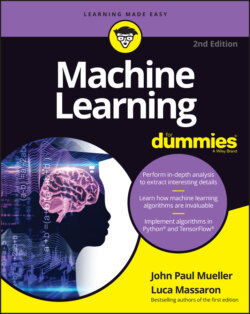Читать книгу Machine Learning For Dummies - John Paul Mueller, John Mueller Paul, Luca Massaron - Страница 16
Exploring what machine learning can do for AI
ОглавлениеMachine learning relies on algorithms to analyze huge datasets. Currently, machine learning can’t provide the sort of AI that the movies present. Even the best algorithms can’t think, feel, present any form of self-awareness, or exercise free will. What machine learning can do is perform predictive analytics far faster than any human can. As a result, machine learning can help humans work more efficiently. The current state of AI, then, is one of performing analysis, but humans must still consider the implications of that analysis — making the required moral and ethical decisions. The “Considering the Relationship between AI and Machine Learning” section of this chapter delves more deeply into precisely how machine learning contributes to AI as a whole. The essence of the matter is that machine learning provides just the learning part of AI, and that part is nowhere near ready to create an AI of the sort you see in films.
The main point of confusion between learning and intelligence is that people assume that simply because a machine gets better at its job (learning) it’s also aware (intelligence). Nothing supports this view of machine learning. The same phenomenon occurs when people assume that a computer is purposely causing problems for them. The computer can’t assign emotions and therefore acts only upon the input provided and the instruction contained within an application to process that input. A true AI will eventually occur when computers can finally emulate the clever combination used by nature:
Genetics: Slow learning from one generation to the next
Teaching: Fast learning from organized sources
Exploration: Spontaneous learning through media and interactions with others
